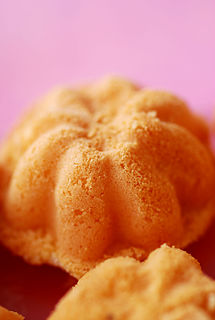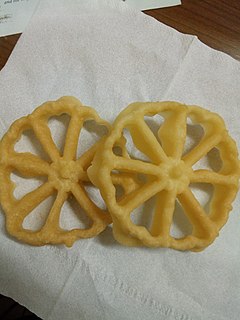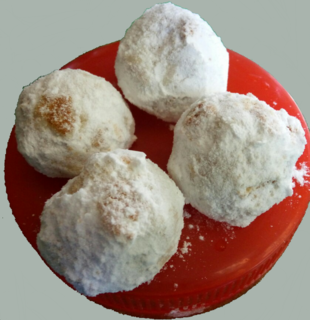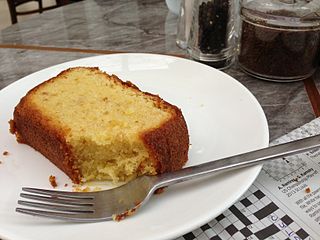Devil curry also known as curry Debal in Kristang is a very spicy curry flavoured with candlenuts, galangal, mustard seed and vinegar from the Eurasian Kristang (Cristão) culinary tradition in Malacca, Malaysia. It was historically served one or two days after Christmas and on other special occasions.

Kuih are bite-sized snack or dessert foods commonly found in Southeast Asia. It is a fairly broad term which may include items that would be called cakes, cookies, dumplings, pudding, biscuits, or pastries in English and are usually made from rice or glutinous rice. The term kuih is widely used in Malaysia, Brunei, and Singapore, and kueh or kue is used in Indonesia, to refer to sweet or savoury desserts. Though called by other names, one is likely to find various similar versions of kuih in neighbouring countries, such as Vietnam, Thailand, and Myanmar. For example, the colourful steamed kue lapis and the rich kuih bingka ubi are also available in Myanmar, Thailand, and Vietnam. In the Philippines, kuih are referred to in Tagalog as kakanin.

Kue kochi or koci is a Maritime Southeast Asian dumpling found in Javanese, Malay and Peranakan cuisine, made from glutinous rice flour, and stuffed with coconut fillings with palm sugar.

Putu piring or kuih tutu is a round-shaped, traditional steamed rice flour kue or sweet snack filled with palm sugar. It is found in Singapore, Malaysia, and Southern Thailand under various names. It is usually made using stainless steel molds with a distinctive flower shape. The Singaporean kuih tutu tend to be thicker and rounder, while putu piring from Malaysia and Southern Thailand tend to be flatter with a disc-like shape. Its composition is quite similar to the cylindrical putu bambu, which are steamed using bamboo tube containers instead.

Pinjaram, also known as penyaram, kuih UFO or kuih telinga tikus is a traditional kuih for the Bajau as well for the Bruneian Malay people in Brunei and in the state of Sabah in Malaysia.

Kelupis is a traditional kuih for the Bruneian Malay people in the country of Brunei and in the states of Sabah and Sarawak in Malaysia. It is also a traditional snack for the Bisaya people as the three ethnics are ethnically related which is Lun Bawang/Lundayeh also create this kelupis especially on the wedding ceremony.

Clorot, celorot, cerorot, or jelurut is an Indonesian traditional sweet snack of sweet and soft rice flour cake with coconut milk, wrapped with janur or young coconut leaf in cone shape. It is a popular traditional sweet snack commonly found in Indonesia, Malaysia and Brunei.

Kue semprong, Asian egg roll, sapit, sepit, kue Belanda, or kapit, is an Indonesian traditional wafer snack made by clasping egg batter using an iron mold which is heated up on a charcoal stove. It is commonly found in Indonesia, Malaysia, Singapore and Brunei.

Bahulu or baulu is a traditional Malay pastry (kue/kuih). It is similar in concept to the madeleine cake, but round in shape and composed of different ingredients. There are three versions available, the most common being bahulu cermai (star-shaped) and the more elusive bahulu gulung and bahulu lapis (layered). Bahulu is believed to be originated in Malay Peninsula during the colonization era and is the corruption of the Malaccan Kristang word, bolu which means cake. It is usually served during Eid al-Fitr as well as during the Chinese New Year.

Kue kembang goyang or kuih loyang is an Indonesian and Malaysian flower-shaped traditional snack (kuih), associated with Betawi cuisine and Malay cuisine.

Kue cucur (Indonesian) or kuih cucur (Malay), known in Thai as khanom fak bua or khanom chuchun, is a traditional snack from Indonesia, and popular in parts of Southeast Asia, includes Indonesia, Malaysia, southern Thailand and Singapore. In Indonesia, kue cucur can be found throughout traditional marketplaces in the country; the popular version, however, is the Betawi version from Jakarta. In Brunei and Malaysia, the term cucur is generally used to refer to any type of fritters. A popular type of cucur in Brunei and Malaysia is Jemput-jemput and Pinjaram. In Southern Thailand, it is often featured in wedding ceremonies and festivals.

Dadar gulung is a popular traditional kue of sweet coconut pancake. In Malaysia, Singapore and Brunei, it is called as Kuih Ketayap or Kuih Lenggang or Kuih Dadar. In Indonesia, it is called dadar gulung, often described as an Indonesian coconut pancake. It is commonly found in Brunei, Indonesia, Malaysia, Singapore and Sri Lanka.

Caozaiguo or shuquguo is a type of kuih with a sweet dough made with glutinous rice flour, sugar, and a ground cooked paste of Jersey cudweed or Chinese mugwort. The herbs give the dough and the finished kuih a unique flavor and brownish green color. The kuih is a found in Fujian, Hakka, and Taiwanese cuisine.

Tao kuih is a kind of traditional food in Chaoshan area, Guangdong, China. Tao means peach in Chinese and kuih (粿) is a general name of a class of food, which is made from rice flour, flour and tapioca. “净米也,又米食也” is the explanation of kuih from Kangxi Dictionary. In Chaoshan area, the housewife always make tao kuih in some big festivals, such as Spring Festival, Lantern Festival, Double Ninth Festival and so on. Tao kuih uses to sacrifice to ancestors. Tao kuih gets its name because people think it looks like a red peach. It is made for worship. In China, red peach symbolizes longevity and luck, it reflects people's aspiration when they pray.

Kue makmur is a traditional Malay kue or kuih. This cake made from butter, ghee and flour, and served during special occasion of Eid al-Fitr. Kue makmur is identified with its white colour and usually in a round shape.

Red peach cake, also known as rice peach cake and rice cake is a small teardrop shaped Teochew kuih (pastry) with soft sticky glutinous rice flour skin wrapped over a filling of glutinous rice, peanuts, mushrooms, and shallots. The skin of the kuih is often dyed pink, and shaped with a wooden mould before steaming. The cake is native to the Teochew people.
Breudher, also known as Brueder or Bloeder, is a traditional Sri Lankan Dutch Burgher buttery yeast cake, baked in a fluted mould. A variation, Bleuda, Kueh Bleuda or Kue Bludder is also found in the Malacca Dutch Eurasian community and in Kochin, a city in the south-west of India.

Yi bua is a traditional Hainanese kuih. It is a Hainanese steamed dumpling made of glutinous rice flour dough. Also known as kuih e-oua, it is filled with a palm sugar sweetened mixture of grated coconut, toasted sesame seeds and crushed roasted peanuts, wrapped with sheets of banana leaves pressed into a fluted cup shape, and customarily marked with a dab of red food colouring. This kuih is traditionally served during a wedding and a baby's full-moon celebration.

Mont kywe the is a traditional Burmese snack or mont. It bears resemblance to the Indonesian and Malaysian kuih kosui and Filipino kutsinta.

Sugee cake is a cake made of semolina and almonds, creamed butter, eggs, and brandy, and optionally covered in marzipan and royal icing. The cake is typically baked during festive occasions and holidays like Christmas, by members of the Eurasian community in Malaysia and Singapore. The word sugee has its origins in Hindustani word for 'semolina' (सूजी).

















